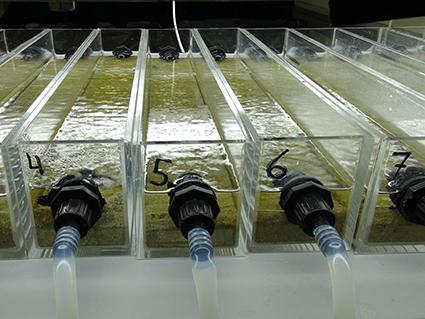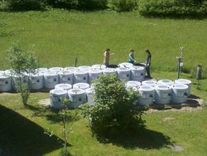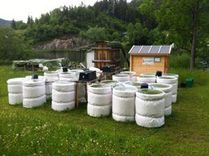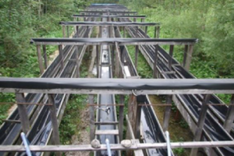Facilities
Transnational Access
Metadata & Data
Papers & Reports
Knowledge Base
Lunz Mesocosm Infrastructure (LMI)
WasserCluster Lunz (WCL)
Infrastructure Description
The Lunz Mesocosm Infrastructure (LMI) belongs to WasserCluster Lunz (WCL), an inter-university research centre of the University of Vienna, the University of Natural Resources and Life Sciences Vienna (BOKU) and the Danube University Krems. It includes 2 permanent land-based mesocosm systems: 40 mesocosms holding 320 L of water each are equipped with a special port to minimize sample contact in experiments targeting dispersal limitation; 24 additional mesocosms holding 400 L each and placed next to a cabin are equipped with a filling system filtering water. Both are equipped with computer-controlled heating and mixing systems. In addition, LMI comprises three experimental flume systems. The Benthic Flumes consist of 6 streamside channels (40 m long, 0.4 m wide) that are continuously fed with stream water. Basic hydraulic and sediment characteristics can be adjusted and solutes such as inorganic nutrients or DOM be added. The Hyporheic Flumes consist of 6 deep channels (5 m long, 0.5 m wide, 1 m deep) filled with gravel and fed with oligotrophic stream water in flow-through mode. Inlets and outlets at different depths (0.2, 0.4, 0.6, 0.8, 1 m) allow for gradually lowering and increasing water levels to study effects of intermittency on hyporheic communities and processes. And there is an indoor flume system where water is channelled through 42 acrylic glass flumes (0.5 m length, 9cm width, 10 cm depth) connected either in parallel or in series. Each flume is operated by an individual aquarium pump in either flow-through or circulating mode, allowing to study biogeochemical turnover processes per flume under controlled temperature and light conditions.
Available infrastructure and instruments beyond the mesocosm facilities include 3 boats and 2 cars, several labs, including a radio-isotope lab (3H,14C), walk-in environmental chambers, elemental analyser coupled to isotope-ratio mass spectrometer (IRMS), GC-FID/MS for analysing fatty acids, HPLC, flow cytometer, total organic carbon (TOC) analyser, nutrient autoanalyser, bench spectrophotometer, fluorometer; PhytoPAM fluorometer, and dissecting, bright- field, inverted and epifluorescence microscopes. Field gear and instrumentation is also available including sampling gear, nets of various mesh sizes, water collection tubes. temperature sensors. Equipment and gear used in the Hyporheic Flumes include a fully automated discharge and water-temperature interface, data loggers, a flow velocity measurement system, a remote-controlled (IR) video system, electrofishing devices, sampling gear, tanks for hatching and maintaining fish, and more.



Facility Description
1A) WCL-Mesocosms-AquaScale (Robert Ptacnik) 40 land-based mesososms (320 L each); water pipes for aeration and mixing; exchangeable inner walls; app. 500 m from lake; local tab water suitable for experiments (not chlorinated)
1B) WCL-Mesocosms-LipTox (Martin Kainz) 24 land-based mesososms (400 L each), temperatured controlled, aerated, temperature sensors, remote controlled
2A) CARBOCROBE Flumes (Katrin Attermeyer) The EcoCatch flumes, also named the ‘Lunzer Rinnen’ consist of 6 streamside experimental flumes of 40m length in which replicated streams can be simulated. The flumes can be used in two operational modes, in flow-through mode with raw stream water to all flumes, or in recirculation mode, with separate recirculation for each flume. A fact-sheet can be found here.
2B) Hyporheic Flumes (Katrin Attermeyer, Gabriele Weigelhofer) The Hyporheic Flumes consist of 6 deep channels (5 m long, 0.5 m wide, 1 m deep) filled with gravel and fed with oligotrophic stream water in flow-through mode. Inlets and outlets at different depths (0.2, 0.4, 0.6, 0.8, 1 m) allow for gradually lowering and increasing water levels to study effects of intermittency on hyporheic communities and processes.
2C) Indoor Flumes (Gabriele Weigelhofer, Simon Vitecek) Water is channeled through up to 42 acrylic glass flumes (0.5 m length, 9cm width, 10 cm depth) connected either in parallel or in series. Each flume is operated by an individual aquarium pump in either flow-through or circulating mode, allowing to study e.g. biogeochemical processes, grazing of macroinvertebrates, and others, under controlled temperature and light conditions.
Organisation Address
WasserCluster Lunz (WCL)
Dr. Carl Kupelwieser Promenade 5
Lunz am See
A-3293
Austria
Infrastructure Address
Lunz am See
150 km southwest of Vienna
Austria
Information Sources
https://www.wcl.ac.at/index.php/en/research/experimental-facilities
Location
Gallery
Contacts
Mesocosms: Robert Ptacnik
Flumes: Katrin Attermeyer
Controlled Parameters
1A) WCL-Mesocosms-Ptacnik
Air flow; possibly shading; nutrient levels
1B) WCL-Mesocosms-Kainz
Temperature, air flow
2A) Water flow, sediment, DOC, nutrients
2B) Inundation/water flow, DOC, nutrients
2C) water flow, temperature, DOC, nutrients, pollutants
Research Topics
Please contact the respective group leaders for ongoing research
WCL Mesocosms 1A,B – Robert Ptacnik, Marin Kainz
Flumes 2A,B,C – Katrin Attermeyer, Gabriele Weigelhofer, Simon Vitecek
Experiment Years
- 2012 - present 2) 2011 - present
TA Support
Services currently offered by the infrastructure: Users have access to mesocosms, office, lab space and the equipment described above. Modern guest rooms for up to 10 users are available. Ample additional lodging options exist. Additional facilities and instruments can be made available at the universities in Vienna (2 h drive). Users of LMI benefit from exceptional scientific experience of the local staff with aquatic mesocosm experiments, long-term data on Lake Lunz and the local streams (Lunzer Seebach), and expertise in freshwater biodiversity, aquatic ecology and biogeochemistry of the academic and technical WCL staff, which has pursued a highly active and international research programme since the opening of WCL in 2005.
Support offered under AQUACOSM: Users will have access to office and lab space, dormitories and other lodging facilities as well as equipment available at the WCL. Cooperation with local scientists is encouraged to take full advantage of their expertise and access to analytical instruments. Technical assistants at WCL will train all users prior to and during their research activities. Coordination meetings before each experiment will optimize the scientific outcome of all activities.
Support offered under AQUACOSM-plus: Users will have access to office and lab space, dormitories and other lodging facilities as well as equipment available at the WCL. Cooperation with local scientists is encouraged to take full advantage of their expertise and access to analytical instruments. Technical assistants at WCL will train all users prior to and during their research activities. Coordination meetings before each experiment will optimise the scientific outcome of all activities.
TA Modality of Access
Modality of access under AQUACOSM: A total of at least 1040 person-days will be allocated to external users through AQUACOSM Transnational Access provision in years 2-4. Access to a minimum of 8 persons is offered for 40 person-days. The partly temperature-controlled mesocosms will be accessible year round during reserved time slots. Further details about Transnational Access provision at all facilities are described in WP1. Additional charges may apply to special services such as stable-isotope or HPLC analyses.
Support offered under AQUACOSM-plus: Users will have access to office and lab space, dormitories and other lodging facilities as well as equipment available at the WCL. Cooperation with local scientists is encouraged to take full advantage of their expertise and access to analytical instruments. Technical assistants at WCL will train all users prior to and during their research activities. Coordination meetings before each experiment will optimise the scientific outcome of all activities.
TA Accommodation
Some guestrooms at WasserCluster Lunz; numerous guesthouses in Lunz am See


